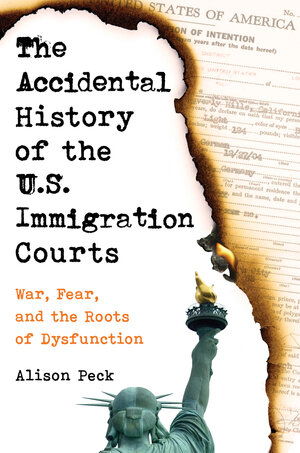
The immigration courts are dysfunctional. As of November 2022, there were more than 2 million cases pending nationwide. Many people wait years to have their cases heard, while others (as of this writing) are forced to “remain in Mexico” pending a hearing.
These controversial policies make daily headlines, but few people are aware of a structural issue that undergirds all these politicized wranglings: The immigration courts are not really “courts” at all, at least not in the conventional understanding of the term. They are not part of the federal judicial branch, created under Article III of the Constitution. Structurally speaking, the immigration courts are simply an office in the Department of Justice—the nation’s chief law enforcement agency.
Immigration judges are lawyers who work for DOJ. They are subject to DOJ personnel policies with respect to hiring, performance standards, and termination. That means that an individual in immigration court finds that their case will be decided by a lawyer who works for the United States—the very party that is suing them. The point is not merely esoteric; a regulatory power called “self-referral” provides that the attorney general—the nation’s chief law enforcement officer—has the authority to re-decide any case in immigration court at any time for any reason. No matter how impartial any individual immigration judge may strive to be, the system ensures that the immigration courts remain under the control of a politically-appointed law enforcement officer who answers directly to the president.
This system is, as Senator Edward Kennedy once said, “a recipe for mistakes and abuse.” How did the United States arrive at this highly manipulable system for deciding immigration cases, which can often be a matter of life or death for the individual standing before the immigration court?
The Accidental History of the U.S. Immigration Courts explores the history behind the creation of the immigration court system and uncovers a surprising answer: At the outbreak of World War II, officials in the Department of State feared that a “fifth column” of Nazi spies who looked like locals would infiltrate the government. Postwar research has revealed that there was no “fifth column,” just a Nazi hoax to undermine Allied morale. President Roosevelt responded by hastily moving the immigration services to DOJ, where they could work closely with the FBI to catch would-be spies. More than eighty years later, the effect of that propaganda lingers in U.S. policy in the form of an immigration court system that remains under the thumb of law enforcement.
After years of teaching courses about immigration and administrative law and thinking out loud with my students about the structure of the executive branch, I could not explain why the immigration courts would be located in DOJ, a law enforcement agency. During the Trump administration, my Immigration Law Clinic students and I became keenly aware of the manipulability of this system, as Trump’s attorneys general “self-referred” seventeen cases for re-decision in four years, almost as many as in the previous seventy-six years combined since the self-referral power was created in 1940. Many of those decisions uprooted years of settled precedent, leaving some of our clients without remedies that had previously been available.
In my administrative law courses, I teach students about the ways in which the Constitution is designed to ensure that executive power is balanced by both the legislative and the judicial power. This balance is essential to ensure that due process is given in legal proceedings with serious consequences, another fundamental value enshrined in both the Fifth and the Fourteenth Amendments. Despite the Founding ideal of the balance of powers, overweening executive power has been a concern to many law and public administration scholars since at least the FDR presidency. Many scholars focus on the New Deal and its expansion of federal economic legislation, with new federal agencies to implement them, as the fulcrum around which power shifted toward the executive.
My research revealed that the FDR administration’s broad view of executive power also affected immigration justice and continues to do so to this day. Although civil rights-minded cabinet members and others in the FDR administration cautioned the president against moving immigration services (which then included both the investigation and the adjudication functions) into a law enforcement agency, FDR demurred that he had no alternative in light of the war threat. After more than a year of study and reluctance, FDR yielded to the advice of his influential Undersecretary of State, Sumner Welles, and made the move.
One of my favorite moments in the book—and in researching it—appears on pages 97-98. On Tuesday, May 21, 1940, FDR had summoned his attorney general, Robert H. Jackson, to the White House for lunch. (Jackson would soon be appointed to the U.S. Supreme Court, where he would be one of the dissenters in Korematsu v. United States, the case that upheld the internment of Japanese-Americans during the war.)
Roosevelt already knew that his attorney general was opposed to moving the immigration services from the Department of Labor, where they were located at that time as part of federal workforce development policy, to his Department of Justice. Jackson had gotten wind that Welles and others at State were urging the president to make the move, but the phone message from Jackson’s assistant that morning merely invited him to meet the president for lunch at 1 p.m., with no mention of the subject of the meeting.
I found that phone message in Jackson’s files in the Library of Congress (and was bemused to note that the caller said “[t]hey would like an immediate response,” as if a summons to lunch with the president were likely to be ignored for long). In the same file folder, I found a memorandum that Jackson had apparently typed or dictated shortly after his return to the office—a memo I felt Jackson had left waiting expressly for me, some eighty years later, to find.
In his memo, Jackson wrote, “May 21, 1940. I was invited to lunch with the President and shortly after lunch arrived he handed me an Executive Order which proposed an immediate transfer of the Bureau of Immigration and Naturalization from the Department of Labor to the Department of Justice. He turned to his soup and left the move to me. I read the order.” Jackson told the president that he had no desire to head the immigration services. The task, he said, “was one which no man could long perform in a period of public excitement; that there was somewhat the same tendency in America to make goats of all aliens that in Germany had made goats of all Jews.” Jackson recommended stronger border control and supervision of resident noncitizens but was “utterly opposed to a new policy of persecuting or prosecuting aliens just because of alienage”—a sentiment with which FDR said he agreed. Jackson recommended a special national defense agency to deal with “alien control, sabotage, espionage, and subversive activities”—this was seven years before the establishment of the CIA—and he felt that these activities should properly be “preventive, rather than remedial.” The President, however, was “not persuaded” and said that “at least for the time being” the immigration services needed to move to DOJ. Dutifully, Jackson proceeded to arrange the transfer.
FDR’s fateful decision to move the immigration services to DOJ has had lasting consequences. Federal officials have long recognized that combining immigration law enforcement and adjudication functions in a law enforcement agency implicated due process and separation of powers concerns, and a few corrective efforts have been made. In 1983, DOJ by regulation created its Executive Office for Immigration Review (EOIR) and placed all immigration judges and adjudication functions within it. This created some separation between the immigration investigation and prosecution functions, which remained in DOJ’s Immigration and Naturalization Service (INS), and the adjudication functions of EOIR.
In the late 1990s, Congress commissioned a study on immigration reform, which noted the anomaly of having adjudication within a law enforcement agency and recommended that the immigration courts be moved to a new and independent agency. Then 9/11 occurred. In the wake of the terrorist attacks, momentum in Washington shifted toward the creation of a national security agency. In the frenzied drafting and negotiation of the Homeland Security Act, the George W. Bush administration pressured Senate Republicans to vote to move the immigration courts into the new Department of Homeland Security (DHS), essentially doubling down on the Roosevelt administration’s policy of coordination between immigration enforcement and national security. Only the vote of one senator—Sam Brownback of Kansas, an evangelical Christian with a concern for refugees and ranking member of the Senate Subcommittee on Immigration—prevented the move. Instead, the 2002 act legislatively fixed the location of EOIR within DOJ, while the investigation and prosecution functions of INS moved to the new DHS.
While that 2002 legislation ensured that immigration investigation and adjudication would be done by separate agencies, the aggressive self-referral record of the Trump attorneys general has raised renewed concerns about the location of adjudication within DOJ. In 2022, Representative Zoe Lofgren introduced H.R. 6577, the Real Courts, Rule of Law Act of 2022, which would have moved immigration adjudication to a new Article I court system, akin to the U.S. Tax Courts. The bill was reported by the Committee on the Judiciary and discharged from the Committee on the Budget on December 20, 2022. The fate of such efforts in the 118th Congress is uncertain.
If Article I immigration courts were created, immigration adjudication would technically remain within the executive branch, but with much greater independence from the president and without the self-referral power of the attorney general. Such a move would not change the underlying immigration laws—whether or how those laws need to change is a separate issue. The creation of Article I immigration courts would simply ensure that the United States moves toward its ideal of an impartial justice system for all.


Alison Peck is the James M. Steptoe and Robert D. Steptoe Professor of Property Law and codirector of the Immigration Law Clinic at West Virginia University. She regularly represents clients before the U.S. immigration courts.